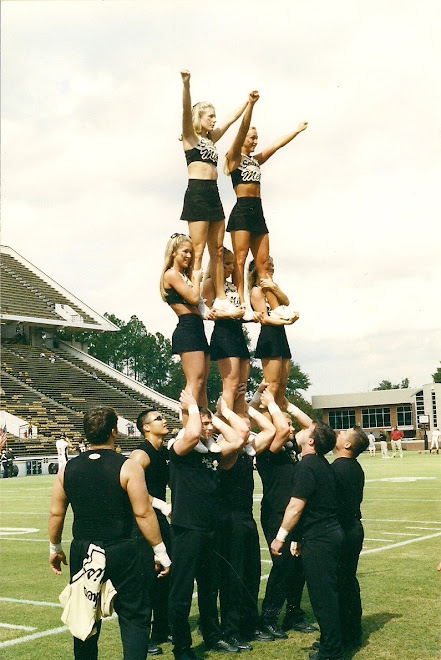September 7, 2010
The night of September 7th, 2010, I instructed the class on how to create a blogspot for e-portfolio use. Normally, the form of a blog is not what you would expectan e-portfolio to look like. However, if you structure the blog with specific pages and other gadgets as sections of your e-portfolio, it makes them easily accessible, no matter your position on the site. This allows for ease of use and quick referencing for anyone viewing your credentials and platforms.
This form of website that lists things about you is highly effective as a resume document, as it allows visuals like pictures, video, and ample written proof of success wihout overwhelming or boring the viewer. One could also create a site for a classroom to discuss things, for example: Mrs. Weaver's 6th Grade Class could post blogs about homework assignments, and projects upcoming. That way, students would have no excuse about losing assignment papers before they made it home.
On the negative side, not every student/parent will have access to a computer at night to check these sites to make them feasible to run the classroom as far as assignment giving and record keeping. Students should be encouraged to have library cards so they may utilize public library computers when possible.
The knowledge needed to create one of these website is just reading and exploring. You have to play with the site for a long time before you figure out how you want your lay out and what design, etc, but if you have time, patience, and can read instructions, you can create a website like this!
Also this night, another student demonstrated how to take short clips of videos and create a composite video. By using transitions, audio, and text overlay, one can create all types of video using this skill. Free software can be downloaded to create video. Windows Movie Maker comes standard on many Windows computers. This is a great tool for creating educational videos, but one must take into consideration the time it takes to shoot, collect, organize, and edit video.
September 14th, 2010
Class did not meet this week. We were to meet with our groups and head to a school to analyze how they are using technology. Our group had to postpone our school trip because the school we chose, Cordozia Middle School, has yet to get their systems up an running, as it is a new development. We will visit two or three different types once we are allowed to come view what they are doing.
September 21st, 2010
This night there were two different examples of technology in the classroom taught. The first student showed how to burn a cd. To do this, you must have compact disks that are rewritable to the media you are trying to burn. You load the media you want to burn onto the software you are burning it with. Then, rearrange how you want the music, data, or videon. To finish, just hit BURN and you have all of your material on a cd for transpot.
This is handy for turning in multi-media work and could be great in the classroom to store more in-depth creative work. On the other hand, students should be monitored when using this in the classroom, as to not allow downloading and burning of inappropriate material.
The second exhibit was a really interesting multimedia video making website called www.xtranormal.com. This site can be used to create educational video using characters that speak in a very clear tone, and are generic in appearance. This is great for eliminating verbal and nonverbal cues that may be a distraction to students, such as a teacher who stutters or a teacher who is inappropriately dressed. However, teacher interaction and student/teacher relationship is detrimental to the learning process, especially in younger students. Human interaction is second to none in development and should not be replaced by technology.
September 28, 2010
This date is another scheduled time for visits to school. I intend to email my group members or call them to see what our plan is.
October 5th, 2010
I spoke with group members. Darron Daniels is sharing his school, Cordozia, and we are also doing Brinkley Middle. I have a business conference in Lake Charles this week and was unable to attend class. I agreed to help with the power point presentation and answer questions as I could. I do not teach myself, so some of the questions were impossible to answer. I took questions 4 and 5.
October 12th, 2010
I answered questions 4 and 5 of the questionairre. I have posted my answers below.
4. Question: What technologies do you have you had experience with in school systems? In Katy, Texas, Verizon Wireless provided aircards to make the laptops for students internet accessible. Verizon also works in conjunction with Cradlepoint. Cradlepoint creates a wireless mobile broadband router that allows 32-300 users to have internet access, completely wirelessly. Several American schools are beginning to look into these for school bus installations so that students can work on school work on their transit, and better utilize their time. Verizon also has technology for vehicle tracking systems to put in place in school buses for a fraction of the cost of the traditional "black box" setup for fleet management. It would allow the school to find the best route for buses to save fuel, tell the school if the bus driver is speeding, and create a breadcrumb trail of everywhere the bus went.
5. Question: What are your technology compentencies/affiliations? I work for Verizon Wireless, who is the most innovative wireless communications company in the U.S. Although not a network engineer, a data specialist, or an IT person, I use, sell, and teach customers how to use wireless applications of all kinds to better manage theit time, their businesses, and their lives. We have about 50 solution alliance partners that we work with, such as Cradlepoint, mentioned in number 4 that generates mobile broadband technology to multiple users. We install and operate personal Mifi devices for 5 users to have internet. One partner is named Cortado - they allow you to connect to a printer or fax machine wirelessly via bluetooth from your cell phone to print work on paper. That could be quite useful in school! There are many, many others, but the Cortado printing and wireless routing would be two useful examples in schools.
skip to main |
skip to sidebar

The Weaver Family 2009

2-2-1 Pyramids during a game.

USM at Tulane 2004

Welcome to Mrs. Weaver's e-portfolio!
Hello and welcome to all! This site is a collection of the personal standards and educational philosophy of Mrs. Jenny L Weaver. Additionally, required INTASC (Interstate New Teacher Assessment and Support Consortium) Standards are incorporated throughout the entries in order to clearly prove that all qualifications have been achieved.
I hope navigation through this new model of a professional educator's portfolio is easier, more interesting, and better yet, saves lots of paper! :) Required main section, the Philosophical Section is a blog entry. The Personal Standards Section, INTASC Standards section, Unit Plan example, and Unit Assessment example are pages linked directly below. Accomplishments, community involvement, associations, and teaching resource links are located in the side column. All links are active, so click them!
I hope navigation through this new model of a professional educator's portfolio is easier, more interesting, and better yet, saves lots of paper! :) Required main section, the Philosophical Section is a blog entry. The Personal Standards Section, INTASC Standards section, Unit Plan example, and Unit Assessment example are pages linked directly below. Accomplishments, community involvement, associations, and teaching resource links are located in the side column. All links are active, so click them!
EXTRA PAGES
~~~~~~~~~~~~~~~~~~~~~~~~~~~~~~~~~~~~~~~~~
Subscribe to:
Comments (Atom)
Profile/Vita
Search This Blog
The Weavers

The Weaver Family 2009
Accomplishments and Associations
NEWTON LITTLE THEATRE
**The Sound of Music
**Carousel
**The Music Man
**A Christmas Carol
**The Wizard of OZ
**Smoke on the Mountain
**Vaudeville
**South Pacific
NEWTON ELEMENTARY SCHOOL
**LIFT (talented and gifted program)
**ECTAG competition(s) winner
**Tiger Cubs, pee wee cheer squad
**Cheered in Houston Thanksgiving parade, 7th grade
NEWTON HIGH SCHOOL
DIPLOMA 2001
**East Central Talented and Gifted
**All State Honors Choir, 3 years
**All State Show Choir, 2 years
**UCA All Star Cheerleader, 2 years
**Mock Trial, 2 years
**Newton High School Most Talented 2001
**Newton County's Junior Miss 2001
**All State Cross Country, 2 years
**Began Newton's 1st cross country team
**FBLA desktop publishing 2000
**Beta club, 5 years
**Newton High School Jazz Band
**Media Club SLAM winner, 2 years
**active contributor to school paper, "The Tiger Roars"
____________________________________
UNIVERSITY OF SOUTHERN MISSISSIPPI
BACHELORS OF ARTS 2006
major: Speech Communications
minor: Deaf Education
**Phi Eta Sigma, Freshman Honor Society
**Dean's List
**Student Athletic Advisory Committee
**USM Varsity Coed Cheer, 3 years
**USM Varsity Cross Country, 1 year
**Speech Communications Association
______________________________________
JACKSON STATE UNIVERSITY
MASTERS OF ARTS IN TEACHING 2012
**Currently enrolled
______________________________________
UNIVERSAL CHEERLEADERS ASSOCIATION
** 5 year veteran instructor award 2005
** 6 year veteran instructor award 2006
**Private camp excellence award 2001, 2002
**Step up to the Plate award 2005
**judged nearly 100 tryouts in Mississippi
**judged both MPSAA and MHSAA state level cheer
competitions
**judged competitions for Central Mississippi Cheerleading
**judged Dixie Regional competitions for UCA
**The Sound of Music
**Carousel
**The Music Man
**A Christmas Carol
**The Wizard of OZ
**Smoke on the Mountain
**Vaudeville
**South Pacific
NEWTON ELEMENTARY SCHOOL
**LIFT (talented and gifted program)
**ECTAG competition(s) winner
**Tiger Cubs, pee wee cheer squad
**Cheered in Houston Thanksgiving parade, 7th grade
NEWTON HIGH SCHOOL
DIPLOMA 2001
**East Central Talented and Gifted
**All State Honors Choir, 3 years
**All State Show Choir, 2 years
**UCA All Star Cheerleader, 2 years
**Mock Trial, 2 years
**Newton High School Most Talented 2001
**Newton County's Junior Miss 2001
**All State Cross Country, 2 years
**Began Newton's 1st cross country team
**FBLA desktop publishing 2000
**Beta club, 5 years
**Newton High School Jazz Band
**Media Club SLAM winner, 2 years
**active contributor to school paper, "The Tiger Roars"
____________________________________
UNIVERSITY OF SOUTHERN MISSISSIPPI
BACHELORS OF ARTS 2006
major: Speech Communications
minor: Deaf Education
**Phi Eta Sigma, Freshman Honor Society
**Dean's List
**Student Athletic Advisory Committee
**USM Varsity Coed Cheer, 3 years
**USM Varsity Cross Country, 1 year
**Speech Communications Association
______________________________________
JACKSON STATE UNIVERSITY
MASTERS OF ARTS IN TEACHING 2012
**Currently enrolled
______________________________________
UNIVERSAL CHEERLEADERS ASSOCIATION
** 5 year veteran instructor award 2005
** 6 year veteran instructor award 2006
**Private camp excellence award 2001, 2002
**Step up to the Plate award 2005
**judged nearly 100 tryouts in Mississippi
**judged both MPSAA and MHSAA state level cheer
competitions
**judged competitions for Central Mississippi Cheerleading
**judged Dixie Regional competitions for UCA
Followers
USM Cheerleading

2-2-1 Pyramids during a game.
Teaching Resource Links
Madeline Hunter's Lesson Plan Template
http://www.windows.ucar.edu/teacher_resources/sci_schools/HunterLessonP.pdf
Edward Fry Readability Graph
http://en.wikipedia.org/wiki/Fry_readability_formula
http://www.windows.ucar.edu/teacher_resources/sci_schools/HunterLessonP.pdf
Edward Fry Readability Graph
http://en.wikipedia.org/wiki/Fry_readability_formula
Southern Miss Cross Country

USM at Tulane 2004
Southern Miss Cheer

